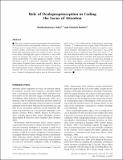Files in this item
Role of oculoproprioception in coding the locus of attention
Item metadata
| dc.contributor.author | Odoj, Bartholomaeus | |
| dc.contributor.author | Balslev, Daniela | |
| dc.date.accessioned | 2016-04-28T23:32:19Z | |
| dc.date.available | 2016-04-28T23:32:19Z | |
| dc.date.issued | 2016-03 | |
| dc.identifier | 231554856 | |
| dc.identifier | 0d9d7a58-285c-404c-83f1-fe79d9f3c3f7 | |
| dc.identifier | 84956642307 | |
| dc.identifier | 000369760000012 | |
| dc.identifier.citation | Odoj , B & Balslev , D 2016 , ' Role of oculoproprioception in coding the locus of attention ' , Journal of Cognitive Neuroscience , vol. 28 , no. 3 , pp. 517-528 . https://doi.org/10.1162/jocn_a_00910 | en |
| dc.identifier.issn | 0898-929X | |
| dc.identifier.other | ORCID: /0000-0001-7843-1044/work/46120509 | |
| dc.identifier.uri | https://hdl.handle.net/10023/8698 | |
| dc.description | This work was supported by the Danish Medical Research Councils (grant number 09-072209 to D. B.). | en |
| dc.description.abstract | The most common neural representations for spatial attention encode locations retinotopically, relative to center of gaze. To keep track of visual objects across saccades or to orient toward sounds, retinotopic representations must be combined with information about the rotation of one's own eyes in the orbits. Although gaze input is critical for a correct allocation of attention, the source of this input has so far remained unidentified. Two main signals are available: corollary discharge (copy of oculomotor command) and oculoproprioception (feedback from extraocular muscles). Here we asked whether the oculoproprioceptive signal relayed from the somatosensory cortex contributes to coding the locus of attention. We used continuous theta burst stimulation (cTBS) over a human oculoproprioceptive area in the postcentral gyrus (S1EYE). S1EYE-cTBS reduces proprioceptive processing, causing ∼1° underestimation of gaze angle. Participants discriminated visual targets whose location was cued in a nonvisual modality. Throughout the visual space, S1EYE-cTBS shifted the locus of attention away from the cue by ∼1°, in the same direction and by the same magnitude as the oculoproprioceptive bias. This systematic shift cannot be attributed to visual mislocalization. Accuracy of open-loop pointing to the same visual targets, a function thought to rely mainly on the corollary discharge, was unchanged. We argue that oculoproprioception is selective for attention maps. By identifying a potential substrate for the coupling between eye and attention, this study contributes to the theoretical models for spatial attention. | |
| dc.format.extent | 647367 | |
| dc.language.iso | eng | |
| dc.relation.ispartof | Journal of Cognitive Neuroscience | en |
| dc.subject | RC0321 Neuroscience. Biological psychiatry. Neuropsychiatry | en |
| dc.subject | NDAS | en |
| dc.subject.lcc | RC0321 | en |
| dc.title | Role of oculoproprioception in coding the locus of attention | en |
| dc.type | Journal article | en |
| dc.contributor.institution | University of St Andrews. School of Psychology and Neuroscience | en |
| dc.identifier.doi | 10.1162/jocn_a_00910 | |
| dc.description.status | Peer reviewed | en |
| dc.date.embargoedUntil | 2016-04-29 |
This item appears in the following Collection(s)
Items in the St Andrews Research Repository are protected by copyright, with all rights reserved, unless otherwise indicated.

